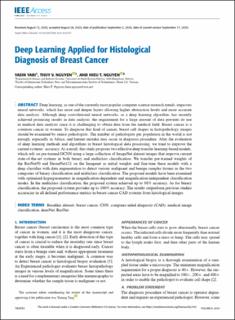| dc.contributor.author | Nguyen, Hieu | |
| dc.date.accessioned | 2021-06-17T12:03:34Z | |
| dc.date.available | 2021-06-17T12:03:34Z | |
| dc.date.created | 2021-02-26T09:33:59Z | |
| dc.date.issued | 2020 | |
| dc.identifier.citation | Yari, Y., Nguyen, T. V., & Nguyen, H. T. (2020). Deep learning applied for histological diagnosis of breast cancer. IEEE Access, 8. | en_US |
| dc.identifier.issn | 2169-3536 | |
| dc.identifier.uri | https://hdl.handle.net/11250/2759979 | |
| dc.description.abstract | Deep learning, as one of the currently most popular computer science research trends, improves neural networks, which has more and deeper layers allowing higher abstraction levels and more accurate data analysis. Although deep convolutional neural networks, as a deep learning algorithm, has recently achieved promising results in data analysis, the requirement for a large amount of data prevents its use in medical data analysis since it is challenging to obtain data from the medical field. Breast cancer is a common cancer in women. To diagnose this kind of cancer, breast cell shapes in histopathology images should be examined by senior pathologists. The number of pathologists per population in the world is not enough, especially in Africa, and human mistake may occur in diagnosis procedure. After the evaluation of deep learning methods and algorithms in breast histological data processing, we tried to improve the current systems' accuracy. As a result, this study proposes two effective deep transfer learning-based models, which rely on pre-trained DCNN using a large collection of ImageNet dataset images that improve current state-of-the-art systems in both binary and multiclass classification. We transfer pre-trained weights of the ResNet50 and DesneNet121 on the Imagenet as initial weights and fine-tune these models with a deep classifier with data augmentation to detect various malignant and benign samples tissues in the two categories of binary classification and multiclass classification. The proposed models have been examined with optimized hyperparameters in magnification-dependent and magnification-independent classification modes. In the multiclass classification, the proposed system achieved up to 98% accuracy. As for binary classification, the proposed system provides up to 100% accuracy. The results outperform previous studies accuracies in all defined performance metrics in breast cancer CAD systems from histological images. | en_US |
| dc.language.iso | eng | en_US |
| dc.rights | Navngivelse 4.0 Internasjonal | * |
| dc.rights.uri | http://creativecommons.org/licenses/by/4.0/deed.no | * |
| dc.title | Deep Learning Applied for Histological Diagnosis of Beat Cancer | en_US |
| dc.type | Journal article | en_US |
| dc.type | Peer reviewed | en_US |
| dc.description.version | publishedVersion | en_US |
| dc.rights.holder | © The Author(s) 2020. | en_US |
| dc.source.volume | 8 | en_US |
| dc.source.journal | IEEE Access | en_US |
| dc.identifier.doi | https://doi.org/10.1109/ACCESS.2020.3021557 | |
| dc.identifier.cristin | 1893914 | |
| cristin.ispublished | true | |
| cristin.fulltext | original | |
| cristin.qualitycode | 1 | |

